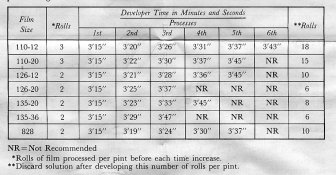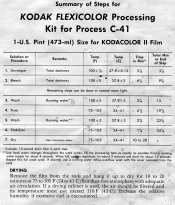Polyglot:
My kit's instructions didn't recommend washes between chemistry steps; they only recommended one at the very beginning. Do you wash between steps because your kit tells you to do this or do you chose to do it this way? I ask because I want to do this. It seems appropriate to get rid of the chemistry and not contaminate the next step.
All:
Where can I get another color kit in the U.S.? I got mine from Freestyle. They have others but they use "blix" (bleach and fix combined) and I hear this is not a good way to go. From what I've read the only kits that use bleach and fix separately are Rollei, Kodak, and Fuji, right? Where can I get a Fuji kit in the U.S.?
Thanks.
Freestyle has a very simple 3 bath developer, the more advanced users have more steps (6 I think) but I could be wrong about the number. Anyway it's good to wash quickly in between baths as you said so there isn't as much cross contamination. Just make sure you get most of the water out so you don't dilute the next chemical.
I'm semi new like you with color chemistry, I've had a real hard time finding E-6 chemistry other than the freestyle and same with C-41, and it's not that I haven't found it, it's that the additional bath steps confuse me and I can't seem to find documentation from a particular company that explains all the bath steps and where to buy them, you would think they would want to sell their product to newcomers but they don't seem to be very good at making it easy on those who haven't done it before, they make assumptions about the level of knowledge their potential market has and are limiting access based on those assumptions. I bet if kodak ran a real add campaign about their film and chemistry and came out with a "beginners kit" and explained all the steps and made it appealing and simple, that they would start selling more film and chemistry, but they are all short sighted and don't understand the potential new market and the old market is dying out, retiring, doing digital. It's really sad how obvious it is to me that none of the color film companies "get it".
Freestyle sort of gets it because they are specifically for students, but they use the 3 bath kits which as PE says are not as good as the 6 bath setups for various reasons. I believe him, he knows A LOT and anyone would be foolish not to listen to his advice. But the access and price points for home users is limiting, there's all sorts of issues with chemistry being sold in large bottles and then the chemistry goes bad, and talk of infusing the bottles with other gasses to keep the chemistry from going bad, but no simple beginner would have those setups, it's really a blind sighted thing, it's super frustrating.
My advice is to perfect your color chemistry development for the 3 bath kits, get good at it, then venture out and learn and read to get a better sense of what else is out there. The film will still be good from the 3 bath kits, it's just some of the details you might not notice now like the darks might be "better" with a 6 bath or something. But that's sort of irrelevant, I would bet that the home development 3 bath kits would still be better than the cheapo lab ones as they probably push their developers to the limit to save $ and that leads to less quality in the image overall... just my opinion of course, I could be wrong...























